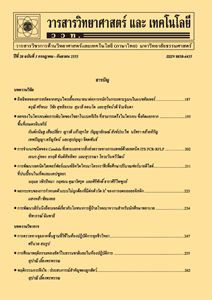เทคโนโลยีการวิเคราะห์ลำดับเบสยุคที่สองและสาม
Main Article Content
Abstract
บทคัดย่อ
การหาลำดับเบสโดยวิธีของแซงเกอร์นับเป็นเทคโนโลยีการวิเคราะห์ลำดับเบสยุคที่หนึ่งและได้ถึงจุดสิ้นสุดเมื่อเกิดเทคโนโลยีการวิเคราะห์ลำดับเบสยุคใหม่ ซึ่งเป็นเทคโนโลยีการวิเคราะห์ลำดับเบสยุคที่สอง (second generation sequencing technologies, SGSTs) และสาม (third generation sequencing technologies, TGSTs) ความแตกต่างของเทคโนโลยีการวิเคราะห์ลำดับเบสยุคที่หนึ่งจาก SGSTs และ TGSTs คือความสามารถของเทคโนโลยีในการวิเคราะห์ลำดับเบสเป็นจำนวนมาก ๆ ในเวลาเดียวกัน SGSTs ได้รับการยอมรับและมีการใช้อย่างแพร่ในช่วงหลายปีที่ผ่านมา รูปแบบหลักของเทคโนโลยี SGSTs เช่น 454/Roche, Solexa, MiSeq, HiSeq/Illumina, SOLiD/Life Technology และ Ion Torrent/Life Technology รูปแบบของเทคโนโลยีเหล่านี้แตกต่างกันโดยหลักการของการวิเคราะห์ลำดับเบส จำนวนและรูปแบบข้อมูลลำเบสที่ได้ โดยสิ่งที่เหมือนกันของทุกเทคโนโลยี SGSTs คือการเพิ่มปริมาณดีเอ็นเอต้นแบบเพื่อใช้ในการวิเคราะห์ลำดับเบส เนื่องจากเทคโนโลยีไม่มีความไวพอในการวิเคราะห์ลำดับเบสโมเลกุลเดี่ยว SGSTs สามารถให้ข้อมูลสายดีเอ็นเอที่มีความยาวตั้งแต่ 25-800 คู่เบส จำนวนหลายล้านถึงหลายพันล้านเส้น แล้วแต่เทคโนโลยี ใช้เวลาในการวิเคราะห์เพียงไม่กี่วัน และมีค่าใช้ต่ำเมื่อเทียบกับเทคโนโลยีการวิเคราะห์ลำดับเบสยุคที่หนึ่ง แม้ว่า SGSTs จะประสบความสำเร็จทางการค้า แต่ก็ยังมีความเร็วไม่มากพอ ให้ข้อมูลลำดับเบสที่ครอบคลุมไม่ดีพอทั้งจีโนม และอาจให้ข้อมูลลำดับเบสที่มีความลำเอียงเนื่องจากต้องมีการเพิ่มปริมาณดีเอ็นเอต้นแบบ TGSTs คิดค้นขึ้นเพื่อใช้ในการวิเคราะห์โมเลกุลเดี่ยวของดีเอ็นเอหรืออาร์เอ็นเอโดยซึ่งเป็นโมเลกุลธรรมชาติ TGSTs มีศักยภาพมากขึ้น สามารถวิเคราะห์ลำดับเบสดีเอ็นเอได้สายยาวมากขึ้น มีค่าใช้จ่ายลดลง ใช้ระยะเวลาในการวิเคราะห์การลดลง และสามารถลดความลำเอียงของการวิเคราะห์ลำดับเบสอันเกิดจากการเพิ่มดีเอ็นเอต้นแบบ นอกจากนี้ยังสามารถประยุกต์ใช้ในงานอื่นนอกเหนือจากการวิเคราะห์ลำดับเบสดีเอ็นเอได้ ในบทความนี้เป็นการกล่าวโดยสังเขปถึงสถานะและรูปแบบของ SGSTs และการเกิดขึ้นของ TGSTs รวมถึงการประยุกต์ใช้เทคโนโลยีการวิเคราะห์ลำดับเบสยุคใหม่นี้
คำสำคัญ : next generation sequencing (NGS); second generation sequencing technologies (SGSTs); third generation sequencing technologies (TGSTs)
Abstract
The era of first generation sequencing dominated by Sanger sequencing quickly came to an end with the introduction of next generation sequencing (NGS). Second and third generation DNA sequencing technologies are emerged as high-throughput approaches to DNA sequencing using the concept of massively parallel processing. The second generation sequencing technologies (SGSTs) have become widely available over the past several years. The 454/Roche, Solexa/ Illumina, SOLiD/Life Technology (ABI) and Ion Torrent are currently the major platforms of SGSTs that differ in sequencing principles, number of read outputs and sequence read formats. The common principle of SGSTs is their need for clonally amplified molecules for sequencing signal detection because of their lack of single molecule sensitivity. These SGSTs generate hundreds of thousands to billions of 25-800 nucleotide-long reads within days in a low-cost manner compared to first generation sequencing. Although the scientific and commercial success of SGSTs, the goal of rapid, comprehensive and unbiased sequencing of nucleic acids has not been achieved. Third generation sequencing technologies (TGSTs) have emerged to analyze natural DNA and RNA molecules in a massively parallel manner with the single molecule DNA sequencing and direct RNA sequencing. TGSTs have potential to increase sequencing throughput and read lengths, decrease costs, run times and error rates, eliminate biases inherent in SGSTs, and offer capabilities beyond DNA sequencing. In this review, we briefly summarize the current state of SGSTs and the emerging TGSTs and outline the broad range of applications for NGS technologies.
Keywords: next generation sequencing (NGS); second generation sequencing technologies (SGSTs); third generation sequencing technologies (TGSTs)


